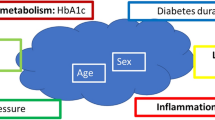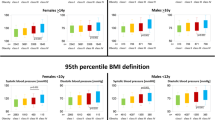Abstract
Objective:
To evaluate the continuous metabolic syndrome score (cMetS) in Indian children and to investigate its relationship with the risk of carotid arterial stiffness.
Methods:
Data on weight, height, mean arterial pressure, serum lipids, insulin, glucose, carotid intima–media thickness and stiffness parameters, that is, pulse wave velocity (PWV), elasticity modulus (Ep), stiffness index (β) and arterial compliance (AC), were assessed in 236 children (6–17 years) from Pune city, India. cMetS was computed using standardized Z-scores for metabolic syndrome (MS) components. cMetS cutoff was obtained by receiver operating characteristic curve analysis across MS components.
Results:
cMetS was lowest (−3.6±2.0) in normal children and highest (3.3±2.4) in MS children. cMetS increased progressively with number of risk components. The cutoff of cMetS yielding maximal sensitivity (80%) and specificity (94%) for predicting the presence of MS was −0.8 (area under the curve=0.921 (95% CI: 0.877–0.964)). In children with cMetS above −0.8, average PWV (4.3±0.6 m s−1), β (3.8±1.2) and Ep (50.4±14.5 kPa) were significantly higher than the respective values (3.7±0.5 m s−1; 3.4±0.8; 37.0±10.0 kPa) in children with cMetS below −0.8, whereas AC was lower (1.2±0.5 mm2 kPa−1) in children with cMetS above −0.8 as against AC (1.4±0.3 mm2 kPa−1) in children with cMetS below −0.8 (P<0.05), demonstrating the risk of stiffness with increasing score. Pearson's correlation coefficients of cMetS with PWV (r=0.575), β (r=0.347), AC (r=−0.267) and Ep (r=0.530) were statistically significant (P<0.01).
Conclusion:
Results demonstrate the usefulness of cMetS over individual MS components as a better tool for assessment of atherosclerotic risk in children.
This is a preview of subscription content, access via your institution
Access options
Subscribe to this journal
Receive 12 print issues and online access
$259.00 per year
only $21.58 per issue
Buy this article
- Purchase on Springer Link
- Instant access to full article PDF
Prices may be subject to local taxes which are calculated during checkout


Similar content being viewed by others
References
National Heart Lung and Blood Institute. Third Report of the National Cholesterol Education Program (NCEP) Expert Panel on Detection, Evaluation, and Treatment of High Blood Cholesterol in Adults (Adult Treatment Panel III): Final report. National Heart, Lung, and Blood Institute: Bethesda, MD, 2002.
International Diabetes Federation. The IDF consensus worldwide definition of the metabolic syndrome. http://www.idf.org.
Brambilla P, Pietrobelli A . Behind and beyond the pediatric metabolic syndrome. Italian J Pediatr 2009; 35: 41.
Katzmarzyk PT, Pérusse L, Malina RM, Bergeron J, Despres JP, Bouchard C . Stability of indicators of the metabolic syndrome from childhood and adolescence to young adulthood: the Québec Family Study. J Clin Epidemiol 2001; 54: 190–195.
American Diabetes Association. Prevention or delay of type 2 diabetes (Position Statement). Diabetes Care 2004; 27 (Suppl 1): S47–S54.
Williams CL, Hayman LL, Daniels SR, Robinson TN, Steinberger J, Paridon S et al. Cardiovascular health in childhood: a statement for health professionals from the Committee on Atherosclerosis, Hypertension, and Obesity in the Young (AHOY) of the Council on Cardiovascular Disease in the Young, American Heart Association. Circulation 2002; 106: 143–160.
Weiss R, Dziura J, Burgert TS, Tamborlane WV, Taksali SE, Yeckel CW et al. Obesity and the metabolic syndrome in children and adolescents. N Engl J Med 2004; 350: 2362–2374.
Berenson GS, Srinivasan SR, Bao W, Newman III WP, Tracy RE, Wattigney WA . Association between multiple cardiovascular risk factors and atherosclerosis in children and young adults. The Bogalusa Heart Study. N Engl J Med 1998; 338: 1650–1656.
Brage S, Wedderkopp N, Ekelund U, Franks PW, Wareham NJ, Andersen LB et al. Features of the metabolic syndrome are associated with objectively measured physical activity and fitness in Danish children: the European Youth Heart Study (EYHS). Diabetes Care 2004; 27: 2141–2148.
Andersen LB, Harro M, Sardinha LB, Froberg K, Ekelund U, Brage S et al. Physical activity and clustered cardiovascular risk in children: a cross-sectional study (The European Youth Heart Study). Lancet 2006; 368: 299–304.
Andersen LB, Haraldsdottir J . Tracking of cardiovascular disease risk factors including maximal oxygen uptake and physical activity from late teenage to adulthood. An 8-year follow-up study. J Intern Med 1993; 243: 309–315.
Eisenmann JC, Welk GJ, Ihmels MA, Dollman J . Fitness, fatness and cardiovascular disease risk factors in children and adolescents. Med Sci Sports Exerc 2007; 39: 1251–1256.
DuBose KD, Stewart EE, Charbonneau SR, Mayo MS, Donnelly JE . Prevalence of the metabolic syndrome in elementary school children. Acta Paediatr 2006; 95: 1005–1011.
Kahn R, Buse J, Ferrannini E, Stern M . The metabolic syndrome: time for a critical appraisal: joint statement from the American Diabetes Association and the European Association for the Study of Diabetes. Diabetes Care 2005; 28: 2289–2304.
Ragland DR . Dichotomizing continuous outcome variables: dependence of the magnitude of association and statistical power on the cutpoint. Epidemiology 1992; 3: 434–440.
Klein BEK, Klein R, Lee KE . Components of the metabolic syndrome and risk of cardiovascular disease and diabetes in Beaver Dam. Diabetes Care 2002; 25: 1790–1794.
Childhood Obesity: By Dr Mala 2005. 24th Karnataka Pedicon. http://www.pediatriconcall.com/fordoctor/Conference_abstracts/childhood_obesity.asp.
Eisenmann JC, Laurson KR, DuBose KD, Smith BK, Donnelly JE . Construct validity of a continuous metabolic syndrome score in children. Diabetol Meta Syndrome 2010; 2: 8.
Vikram NV, Pandey RM, Misra A, Goel K, Gupta N . Factor analysis of the metabolic syndrome components in urban Asian Indian adolescents. Asia Pac J Clin Nutr 2009; 18: 293–300.
Kumar V, Sachdev HPS, Khalil A . Noninvasive evaluation of endothelial function and arterial mechanics in overweight adolescents. Indian Pediatr 2004; 41: 1105–1114.
Ford ES, Ajani UA, Mokdad AH . The metabolic syndrome and concentrations of C-reactive protein among U.S. youth. Diabetes Care 2005; 28: 878–881.
Gungor N, Saad R, Janosky J, Arslanian S . Validation of surrogate estimates of insulin sensitivity and insulin secretion in children and adolescents. J Pediatr 2004; 144: 47–55.
Cole TJ, Bellizzi MC, Flegal KM, Dietz WH . Establishing a standard definition for child overweight and obesity worldwide: international survey. Br Med J 2000; 320: 1240–1243.
Wijndaele K, Beunen G, Duvigneaud N, Matton L, Duquet W, Thomis M et al. A continuous metabolic syndrome risk score: utility for epidemiological analyses. Diabetes Care 2006; 29: 2329.
Hillier TA, Rousseau A, Lange C, Lépinay P, Cailleau M, Novak M et al. Practical way to assess metabolic syndrome using a continuous score obtained from principal components analysis. The D.E.S.I.R. Cohort. Diabetologia 2006; 49: 1528–1535.
Okosun IS, Boltri JM, Lyn R, Davis-Smith M . Continuous metabolic syndrome risk score, body mass index percentile, and leisure time physical activity in American children. J Clin Hypertens (Greenwich) 2010; 12: 636–644.
Gupta R, Deedwania PC, Gupta A, Rastogi S, Panwar RB, Kothari K . Prevalence of metabolic syndrome in an Indian urban population. Int J Cardiol 2004; 97: 257–261.
Misra A, Vikram NK, Arya S, Pandey RM, Dhingra V, Chatterjee A et al. High prevalence of insulin resistance in post-pubertal Asian Indian children is associated with adverse truncal body fat patterning, abdominal adiposity and excess body fat. Int J Obes Relat Metab Disord 2004; 28: 1217–1226.
Ramachandran A, Snehalatha C, Yamuna A, Murugesan N, Narayan KM . Insulin resistance and clustering of cardio-metabolic risk factors in urban teenagers in southern India. Diabetes Care 2007; 30: 1828–1833.
Lehmann ED . Aortic pulse-wave velocity versus pulse pressure and pulse-wave analysis. Lancet 2000; 355: 412.
Pandit D, Kinare A, Chiplonkar S, Khadilkar A, Khadilkar V . Carotid arterial stiffness in overweight and obese Indian children and adolescents. J Pediatr Endocrinol Metab 2011; 24: 97–102.
Sakuragi S, Abhayaratna K, Gravenmaker KJ, O’Reilly C, Srikusalanukul W, Budge MM et al. Influence of adiposity and physical activity on arterial stiffness in healthy children: the Lifestyle of Our Kids Study. Hypertension 2009; 53: 611–616.
Acknowledgements
We would like to express our profound gratitude to all the participants for their cooperation and contribution towards this study. We also express our sincere thanks to the Director of Hirabai Cowasji Jehangir Medical Research Institute and Agharkar Research Institute and to Dr Arun Kinare (Senior Radiologist) for funding this study.
Author information
Authors and Affiliations
Corresponding author
Ethics declarations
Competing interests
The authors declare no conflict of interest.
Rights and permissions
About this article
Cite this article
Pandit, D., Chiplonkar, S., Khadilkar, A. et al. Efficacy of a continuous metabolic syndrome score in Indian children for detecting subclinical atherosclerotic risk. Int J Obes 35, 1318–1324 (2011). https://doi.org/10.1038/ijo.2011.138
Received:
Revised:
Accepted:
Published:
Issue Date:
DOI: https://doi.org/10.1038/ijo.2011.138
Keywords
This article is cited by
-
Metabolic syndrome and risk factors in children: a risk score proposal
European Journal of Clinical Nutrition (2023)
-
Cardiometabolic risk profile among children with migrant parents and role of parental education: the IDEFICS/I.Family cohort
International Journal of Obesity (2023)
-
Metabolite profiles and the risk of metabolic syndrome in early childhood: a case-control study
BMC Medicine (2021)
-
Elevated blood pressure-associated cardiometabolic risk factors and biomarkers in 16–23 years old students with or without metabolic abnormalities
Journal of Human Hypertension (2021)
-
Validity of continuous metabolic syndrome score for predicting metabolic syndrome; a systematic review and meta-analysis
Journal of Diabetes & Metabolic Disorders (2021)



